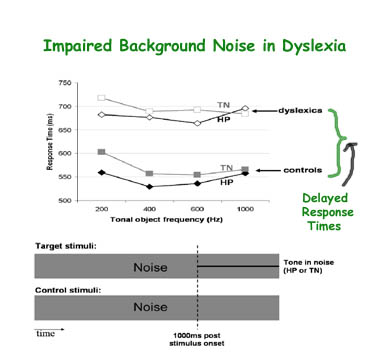It’s time when students are returning to the classroom and the child that struggles with reading and learning have a difficult time learning with background noise.
More data supporting the range of perceptual difficulties in dyslexia.
In the figure below, researchers found that dyslexic subjects showed delayed responses to sounds (HP stands for Huggins Pitch, TN stands for pure tone)when played with background noise.

This background noise can be a big obstacle to efficient classroom learning for dyslexic students. Larger classes sizes, murmurings and rustlings from fellow classmates, and a fuzziness about phonology or weak auditory working memory, can spell failure (or ADD misdiagnosis) for even very smart or determined dyslexic students. This study only looked at tone and Huggins (kind of spectral noise) sounds…a test of similar-sounding phonemes might be even more dramatic.
Many parents and teachers out there might say, “Aha!”. Students with background noise problems often show wide variability in their classroom success, that may be due to teaching style, class size, degree of noise, or seat placement. Be vigilant to the possibility, and help your student advocate for classroom speakers if needed.
Now is this education or neurobiology? Both of course! We do a disservice to children if we can’t find efficient ways to share information between researchers, educators, and parents.
Please join me in signing this petition for Congress to level the playing field for dyslexics in education. The petition was created by the Yale Center for Dyslexia and Creativity.
Dear Deb ,
Thanks for signing our petition, “United States Congress: Legalize Dyslexia: Grant Accommodations to Dyslexic Students..”
Winning this campaign is now in your hands. We need to reach out to as many friends as we can to grow this campaign and win.
Thanks for your support,
Yale Center for Dyslexia & Creativity
| Take the next step: Ask your friends to sign |
|
|
| Don’t just be a signer — be an organizer. Turn your signature into hundreds more by asking your friends to sign. Then they’ll ask their friends. That’s how we win. |
I work with students who are struggling in reading and writing. Every session is individually developed using Orton-Gillingham methods. To learn more about me and discuss your student please contact me:
Deb Dwyer
(218) 340-7393
[email protected]
Dyslexia simply put is a condition that causes difficulty in reading that is unrelated to a person’s intelligence. According to The International Dyslexia Association,
Dyslexia is a language-based learning disability. Dyslexia refers to a cluster of symptoms, which result in people having difficulties with specific language skills, particularly reading. Students with dyslexia usually experience difficulties with other language skills such as spelling, writing, and pronouncing words. Dyslexia affects individuals throughout their lives; however, its impact can change at different stages in a person’s life. It is referred to as a learning disability because dyslexia can make it very difficult for a student to succeed academically in the typical instructional environment, and in its more severe forms, will qualify a student for special education, special accommodations, or extra support services.
DISCLAIMER: No two dyslexic students have exactly the signs or symptoms or responds to remediation in exaclty the same way. People with dyslexia are on a spectrum and often have additional conditions that impact them. The following is generalized information and some students have a few of the signs while others have many. As a tutor, I do an informal assessment to identify what the child knows prior to beginning tutoring. A comprehensive evaluation is important to determine underlining factors.
From the National Center for Learning Disablities
What Are the Warning Signs of Dyslexia?
The following are common signs of dyslexia in people of different ages. If you or someone you know displays these signs, it doesn’t necessarily mean you have a learning disability. But if troubles continue over time, consider testing for dyslexia.
Dyslexia: Warning Signs By Age
Young Children
Trouble With:
- Recognizing letters, matching letters to sounds and blending sounds into speech
- Pronouncing words, for example saying “mawn lower” instead of “lawn mower”
- Learning and correctly using new vocabulary words
- Learning the alphabet, numbers, and days of the week or similar common word sequences
- Rhyming
|
School-Age Children
Trouble With:
- Mastering the rules of spelling
- Remembering facts and numbers
- Handwriting or with gripping a pencil
- Learning and understanding new skills; instead, relying heavily on memorization
- Reading and spelling, such as reversing letters (d, b) or moving letters around (left, felt)
- Following a sequence of directions
- Trouble with word problems in math
|
Teenagers and Adults
Trouble With:
- Reading at the expected level
- Understanding non-literal language, such as idioms, jokes, or proverbs
- Reading aloud
- Organizing and managing time
- Trouble summarizing a story
- Learning a foreign language
- Memorizing
|
More details on Warning Signs can be found at:
http://www.ncld.org/types-learning-disabilities/dyslexia/common-dyslexia-symptoms-warning-signs-in-children-in-grades-3-8
and
http://www.interdys.org/ewebeditpro5/upload/DyslexiaBasicsREVMay2012.pdf
Accommodations for Dyslexia – coming soon
 This background noise can be a big obstacle to efficient classroom learning for dyslexic students. Larger classes sizes, murmurings and rustlings from fellow classmates, and a fuzziness about phonology or weak auditory working memory, can spell failure (or ADD misdiagnosis) for even very smart or determined dyslexic students. This study only looked at tone and Huggins (kind of spectral noise) sounds…a test of similar-sounding phonemes might be even more dramatic.
This background noise can be a big obstacle to efficient classroom learning for dyslexic students. Larger classes sizes, murmurings and rustlings from fellow classmates, and a fuzziness about phonology or weak auditory working memory, can spell failure (or ADD misdiagnosis) for even very smart or determined dyslexic students. This study only looked at tone and Huggins (kind of spectral noise) sounds…a test of similar-sounding phonemes might be even more dramatic.
